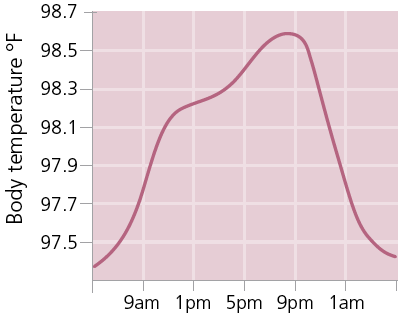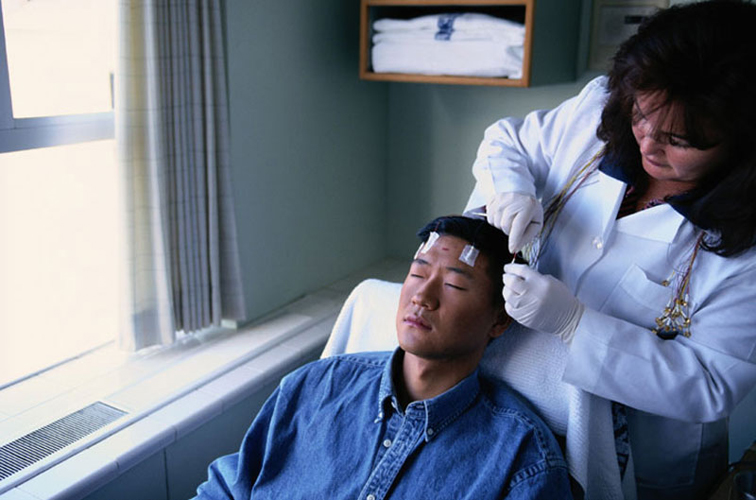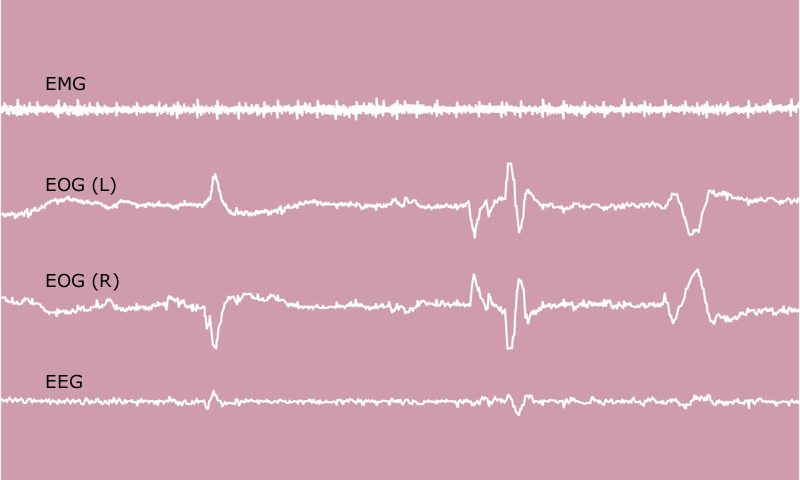| Q: |
What is sleep?
|
| A: |
Everyone knows what sleep is, but would find it difficult to
define. Perhaps the scientist Robert McNish summed it up best when he
wrote in The Philosophy of Sleep
(1834): “Sleep is the intermediate state between wakefulness and death;
wakefulness being regarded as the active state of all the animal and
intellectual functions, and death as that of their total suspension.”
During sleep, our senses are disengaged and we are temporarily
unresponsive to our environment. Sleep involves processes affecting both
our behavior and our physiology (the way the body works).
|
| Q: |
Why do we need sleep?
|
| A: |
Sleep is important to health, and insufficient sleep can lead to
problems with various body systems, including the immune system, the
heart and circulatory system, and hormone secretion. Also, poor-quality
or insufficient sleep can lead to impairment of daytime functioning,
excessive daytime sleepiness, and problems with memory.
|
| Q: |
How much do we know about sleep?
|
| A: |
The study of sleep is an evolving science. We know a lot about
many disorders of sleep but not enough about others. Answers to even the
most common questions about sleep are not always simple or
straightforward, and sometimes there is no answer at all. Studies in
sleep and sleep disorders are a relatively new area of research compared
with many other areas of human health.
|
| Q: |
How long has sleep been studied?
|
| A: |
The study of sleep and sleep disorders is a relatively new
discipline in science and medicine. In 1875, differences in the brain
activity of sleeping and awake dogs were studied using
electroencephalograms (EEGs), which recorded electrical impulses in the
brain. In 1880, the classic features of narcolepsy (a sleep disorder
characterized by excessive daytime sleepiness; see Narcolepsy and abnormal daytime sleepiness)
were described. Specific sleep disorders were identified as interest in
sleep, and the method of documentation of these disorders–the
polysomnogram–evolved. The first narcolepsy clinics were set up in 1964,
and the use of continuous positive airway pressure (CPAP) for the
treatment of sleep apnea was introduced in 1981.
|
| Q: |
What is the sleep-wake cycle?
|
| A: |
The sleep-wake cycle is the alternation between the states of
being awake and being asleep. One theory of sleep states that the amount
of sleep we experience depends on the length of time we are awake prior
to sleep. So, the longer you are awake and the more tired and sleepy
you become, the greater the urge for you to fall asleep and the longer
you are likely to sleep in order for your body to attain “normal
function” again. Some researchers believe there is a separate sleep-wake
cycle that runs on its own rhythm but also interacts with the circadian
rhythm. Many other theories have been developed in order to define how
and why we sleep and what the basic drives to sleep are.
|
| Q: |
What role does cortisol play in the sleep-wake cycle?
|
| A: |
Cortisol is the “stress response” hormone of the body. It has a
marked circadian rhythm, and levels in the blood will vary during the
day and night. Cortisol levels are at their lowest during slow wave
sleep at night. The highest cortisol levels are in the early morning before
sunrise and awakening. This means that your body is prepared to be fully
active when you get up.
|
| Q: |
What role does body temperature play in regulating sleep?
|
| A: |
Sleep onset is likeliest to occur in the downward phase of the temperature cycle (see What are circadian rhythms?).
In other words, we are most likely to sleep when our body temperature
is falling. A secondary peak in sleepiness occurs in the afternoon and
corresponds to afternoon napping. Sleep stops as the body temperature
curve rises.
|
| Q: |
Is environmental temperature important in sleep?
|
| A: |
It is usually more conducive to sleep in a slightly cooler rather
than warmer environment, since this matches the dip in core body
temperature that occurs during sleep. Extremes of temperature (hot or
cold) disrupt sleep.
|
| Q: |
Which parts of the brain are involved in sleep?
|
| A: |
The most important part of the brain involved in the coordination
of the sleep process is called the reticular activating system (RAS).
It is composed of a large number of nerve cells throughout the brain and
is responsible for regulating wakefulness. When the RAS neurons switch
off, alertness is reduced. There is a significant and continuous
interplay between the RAS and other sleep-regulating areas in the brain.
These include the thalamus, medulla oblongata, hypothalamus, pons,
midbrain, spinal cord, pineal gland, raphe nuclei, basal forebrain,
hippocampus, and suprachiasmatic nucleus.
|
| Q: |
Why is the suprachiasmatic nucleus important?
|
| A: |
The suprachiasmatic nucleus is a system of nerve cells
responsible for the circadian rhythm. It is strongly affected by light
and promotes wakefulness, as shown by the high firing rate of the
neurons in the day and low firing rate at night. Neurons from the
suprachiasmatic nucleus project to many areas of the brain including the
thalamus. The suprachiasmatic nucleus also regulates the timing of
melatonin secretion from the pineal gland .
|
| Q: |
What role do light and darkness play in regulating sleep?
|
| A: |
Light activates special receptor cells at the back of the eye
(retina), which in turn affect the suprachiasmatic nucleus. This has
links to other parts of the brain that regulate sleep and wakefulness,
including the pineal gland, which produces melatonin. Exposure to light
increases wakefulness while darkness has the opposite effect. Light is
thus important to the regulation of sleep and wakefulness and helps keep
our circadian rhythm on track. Light is an effective cue for
wakefulness in all humans, except those who lack light receptors in the
eyes (certain forms of profound blindness).
|
What are circadian rhythms?
Circadian rhythms are the
“clocks” of our internal mechanism that determine the phases of our
cellular and organ activity over a 24-hour period. The word circadian
means “about a day.” Circadian rhythms affect body temperature, organ
function, secretion of hormones such as cortisol (the primary stress
hormone), and sleep. Each rhythm affects the others. In an environment
with no time cues (such as light, clocks, calendars) our body clock
completes a cycle that is slightly longer than the natural day–about 24
hours and 42 minutes, rather than exactly 24 hours.
Body temperature and sleep
Our body’s circadian rhythms dictate the rise and fall of our
internal temperature over the course of a day. We are most likely to
fall asleep when our body temperature is in the downward phase.

How is sleep measured and recorded?
Sleep doctors,
sleep technologists, and sleep researchers use a system called
polysomnography (PSG) to record a person’s sleep, to diagnose many sleep
disorders, and to investigate the differences between normal and
abnormal sleep. The PSG is usually performed in a sleep laboratory,
which can be part of a hospital or university research setting.
Sophisticated equipment
is used to collect signals from a sleeping person. An
electroencephalogram (EEG) records brain wave activity. An
electro-oculogram (EOG) records the activity of the eyes and an
electromyogram (EMG) records activity in muscles. Other equipment
collects signals related to breathing (respiration), and records airflow
through the nose and mouth, respiratory effort, movement, and oxygen
and carbon dioxide levels. An electrocardiogram (ECG) monitors heart
rate and rhythm. Electrodes placed on the muscles of the shins, together
with a body position sensor around the waist, record body movement and
leg or arm movement.

Monitoring your sleep
This recording of REM sleep shows the typical rapid eye movements
(EOG), low muscle tone (EMG), and the characteristic brain wave pattern
(EEG). REM sleep is distinct from NREM sleep in that we have an “active
mind inside a paralyzed body.” We often wake up from REM sleep, or just
after it in the morning.
